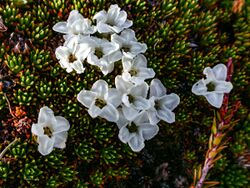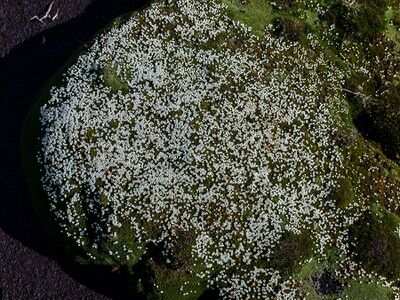Biology:Dracophyllum minimum
| Dracophyllum minimum | |
|---|---|

| |
| Dracophyllum minimum in flower on Mount Field, 2021 | |
| Scientific classification | |
| Kingdom: | Plantae |
| Clade: | Tracheophytes |
| Clade: | Angiosperms |
| Clade: | Eudicots |
| Clade: | Asterids |
| Order: | Ericales |
| Family: | Ericaceae |
| Genus: | Dracophyllum |
| Species: | D. minimum
|
| Binomial name | |
| Dracophyllum minimum F.Muell.
| |
Dracophyllum minimum, commonly known as heath cushionplant or claspleaf heath, is a species of bolster cushion plant endemic to Tasmania, Australia.[1][2] It is a low growing, highly compacted plant with white flowers, commonly found in alpine areas of the south, centre and west of Tasmania.[3]
Description
Dracophyllum minimum is a highly compacted cushion plant that grows close to the ground. It can form a large spreading mat, often interspersed with other cushion plant species such as Oreobolus pumilio, Abrotanella forsteroides, Donatia novae-zelandiae and Mitrasacme archeri. This undulating mat of mixed species is referred to as mosaic cushion heath.[4] The leaves of D. minimum are bright green and sessile, with reddish tips and a broad sheathing base as long as the blade, approx 3 to 4 mm (0.12 to 0.16 in).[4] The flowers are small, solitary, white, and tubular, sitting directly on top of the foliage.[5] The plant can often be mistaken for the vegetatively similar cushion plants Abrotanella forsterioides and Donatia novae-zelandieae, however D. minimum is distinguished by its lack of a hairpoint on the leaf tip or hairy leaf axils.[6] Cuchion plants are extremely slow growing and can occupy sites for a long period of time.[7]
Habitat
Dracophyllum minimum is endemic to Tasmania. It is commonly found in alpine regions of the south, centre and west of Tasmania, at altitudes above 1,200 m (3,900 ft), where snow may lie for several months of the year.[4] It is generally found on shallow fibrous peaty soils with high rainfall and poor drainage.[8] Dracophyllum minimum can grow individually, however it often occurs in cushion plant communities, consisting of a complex mix of cushion plant species, commonly 30 species/m2 (2.8 species/sq ft), forming an extensive undulating mat. These communities can spread up to several hectares in area.[4]
References
- ↑ "Species Dracophyllum minimum". https://www.naturalvaluesatlas.tas.gov.au/#SpeciesPage:89-00594.
- ↑ "Dracophyllum minimum F.Muell.". GBIF. https://www.gbif.org/species/4010619.
- ↑ "Dracophyllum minimum (Ericaceae) 2:261". UTAS. https://www.utas.edu.au/dicotkey/dicotkey/EPACRIDS/sDracophyllum_minimum.htm.
- ↑ 4.0 4.1 4.2 4.3 Gibson, Neil B (1988). "A study on the biology of four Tasmanian cushion species". University of Tasmania Hobart. https://core.ac.uk/download/pdf/33330242.pdf.
- ↑ Howells, C (2012). Tasmania's Natural Flora, Second Edition. Tasmania's Natural Flora Editorial Committee: Tasmania.
- ↑ "EPACRIDACEAE Dracophyllum minimum". University of Tasmania Hobart. https://www.utas.edu.au/docs/plant_science/field_botany/species/dicots/epacrsp/dracmini.html.
- ↑ Kirkpatrick, James; Gibson, Neil (1992). "Dynamics of a Tasmanian Cushion Heath Community". Journal of Vegetation Science 3 (5): 647–654. doi:10.2307/3235832. https://www.jstor.org/stable/3235832. Retrieved 15 March 2021.
- ↑ Kitchener, Anne; Harris, Stephen (2005). From Forest to Fjaeldmark. Descriptions of Tasmania's Vegetation (Volume 2 ed.). Department of Primary Industries, Water and Environment. ISBN 0-7246-6364-9. https://dpipwe.tas.gov.au/Documents/f2f_highland_treeless.pdf. Retrieved 16 March 2021.
Wikidata ☰ Q15377241 entry
 |



